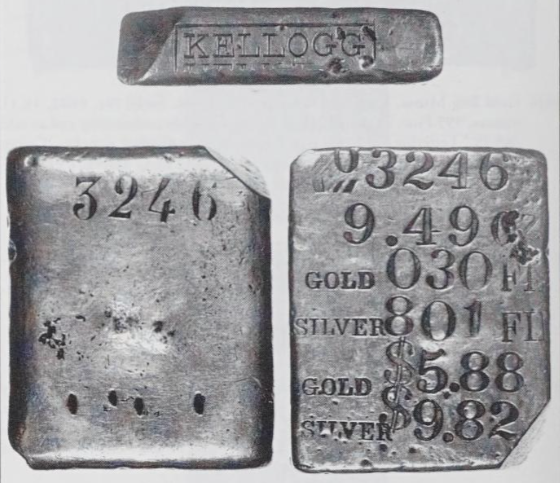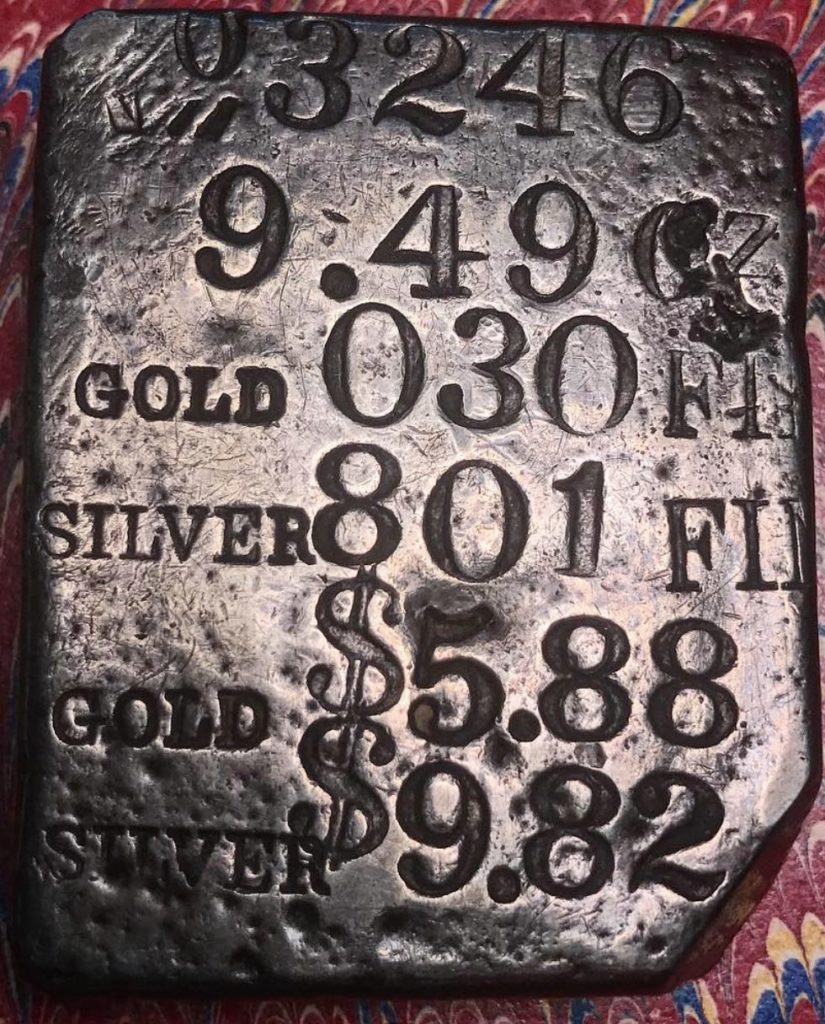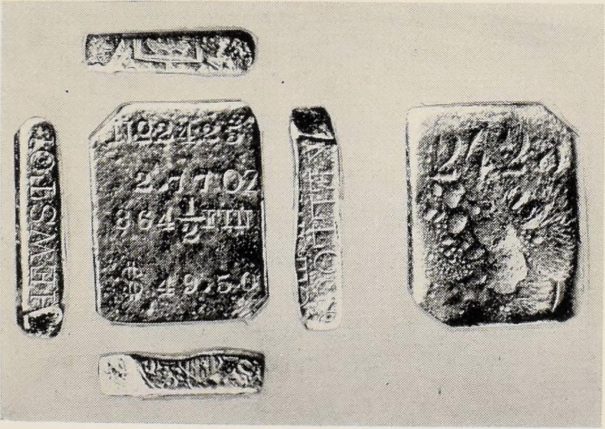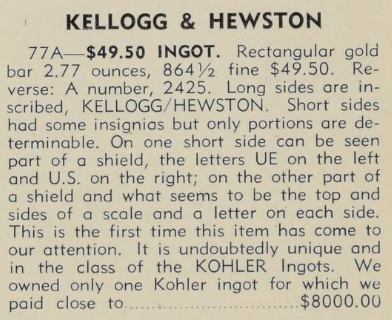John Grover Kellogg was a private assayer that went through several stages of business and historic partnerships:
- Kellogg & Richter through 1855
- Kellogg & Humbert through 1860
- Kellogg, Hewston & Co through 1866
Many of Kellogg & Humbert bars were discovered on the SS Central America shipwreck as a testament to the scope of their operation and trust the community had in their work. In fact, of all the ingots discovered on the shipwreck Kellogg & Humbert’s outnumbered them all. Augustus Humbert was the Assayer for the US Treasury in 1850.
Kellogg & Humbert was dissolved in 1860, and Kellogg organized a new partnership with John Hewston, Jr. and J. H. Stearns, conducting an assaying business at the old 416 Montgomery Street location. Kellogg, Hewston & Co. operated with much success until they sold out in 1866 to the San Francisco Assaying and Refining Works. That firm conducted the business until the financial crisis of 1875, when it passed into the hands of the Selby Lead and Silver Smelting Company.
On April 2, 1860, after Augustus Humbert retired from the business, the operation continued under the name of Kellogg, Hewston & Co., and was conducted by his former associates, joined by J.H. Stearns, who had known Kellogg for a long time and had been a director in 1849 of the Cayuga Joint Stock Co., of which Kellogg was a member. In later years Stearns had served as cashier for Kellogg in several partnerships. During the transition Humbert remained with the firm for a few weeks.
Kellogg went back to New York for a time but soon returned to manage the Pacific Refinery and Bullion Exchange. He died April 21, 1886, leaving a legacy perhaps best stated in the Alta California, whose editors contended that had it not been for Kellogg & CO., the financial community of San Francisco might have been bankrupt.
(Reference: from Donald H. Kagin’s, “Private Gold Coins and Patterns of the United States”, copyright 1981, Arco Publishing, Inc. of New York.)
In 1863, even the famous Thomas Price appears in Langley’s San Francisco Directory for the Year Commencing October 1863 , as an Assayer with Kellogg, Hewston & Co.
9.49 oz Kellogg, Hewston & Company, San Francisco mixed metal silver bar

This ingot represents perhaps the PINNACLE of 19th century ingot collecting. It transcends into many areas of interest including SSCA (SS Central America Shipwreck), US Assay Office, and even Civil War (1864).

This is the ONLY KNOWN silver ingot in private hands, and the only ingot of Kellogg’s not on the shipwreck besides a gold one at the Smithsonian Institution.
Serial No. 3246. 9.49 ounces. Gold 030 Fine; Silver 801 Fine. Gold $5-88; Silver $9.82. Very Fine or better. The serial number appears on both obverse and reverse at top using different sets of number punches. KELLOGG and a partially defaced word (HEWSTON) below, all within a rectangular border, on right edge. Remaining edges blank.
According to records in the files of John J. Ford, Jr., this ingot “was undoubtedly made in February 1864.”
No. 3246 was originally in the Chase-Manhanan Bank collection; deaccessioned by curator Taxay, circa 1965. Later, Lester Merkin to Sidney Smith.
Part of The Century Collection Sale, 1992, Superior Galleries.
[02/1992] https://archive.org/details/centurycollectio1992supe/page/346/
2.77 oz Kellogg & Hewston $49.50 Gold Ingot

No. 2425, 2.77 oz. 864 1/2 Fine, $49.50, Rev. 2425 in antiquated figures. The four edges are lettered and stamped as follows: Lower half of U. S. Shield UE . . . US (for U. S. Revenue); Kellogg Hewston; Upper half of U. S. Shield, VT . EV. Illustrated in Guidebook, 10th edition, page 212.
This splendid and highly prized piece was in the Waldo Newcomer Collection, the famed repository of Pioneer Gold coins. Originally unknown to Edgar Adams when he published his book in 1913, the piece made its debut in a 1929 Auction Sale conducted by Thomas L. Elder, the late renowned numismatist and dealer. Under Lot 975, if we are permitted to extract:
“(1852-54) . . . The San Francisco Directory for 1852 states that John Hewston, Jr. was a smelter and assayer, connected with the U. S. Assay Office and the inclusion of his name on this bar gives it added importance and value, and gives it official standing. It bears a U. S. Shield on its edges and a reference to the rJ. S. Revenue Department, proving it circulated with other coins of the period at its face value.
It is, therefore, a Pioneer Gold coin, in the same class as the Moffat & Co. Ingots of 1849 . . . collected many years ago by an old ‘Forty-Niner’ named Steinhardt, who died a few years ago aged 78 years. He was an old banker and assayer and was known personally to me like Hugo Landecker of San Francisco …. All of the above statements and others in regard to John Hewston, Jr., whose name appears with that of coiners Kellogg & Co., can be verified and amplified. The records show that Hewston officiated between 1852 and 1854, and we all know Kellogg struck much gold in 1854.”
In addition to the above testament by Mr. Elder, we also note mention in the San Francisco Directories of Kellogg & Humbert as Assayers in 1859 (their last year), and Kellogg, Hewston & Co. in 1860. Additional evidence may be gleaned from a 1944 Auction in which were sold a lot of autographed letters to Prof. James C. Booth, Assayer of the U. S. Mint at Philadelphia. Among these letters dated 1853-1857 were a number by John Hewston. Jr, and others interested in gold mining.
Whether struck, as Mr. Elder felt, in 1852-1854 period, or in 1859-60, the presence of the Revenue Stamp made it acceptable for U. S. Customs duties. This splendid specimen has an official character beyond all question and worthy of a most dignified position in a numismatist’s cabinet.
This unique [ingot] is certainly as rare and valuable as any in the Pioneer Gold series and should bring well over the $10,000.00 mark
[08/1956] https://archive.org/details/chianaconvention00kell/page/46/
This ingot now resides in the Smithsonian.


See: https://www.si.edu/object/4950-dollars-kellogg-hewston-united-states:nmah_1101712
77A — $49.50 INGOT. Rectangular gold bar 2.77 ounces, 864 1/2 fine $49.50. Reverse: A number, 2425. Long sides are inscribed, KELLOGG/HEWSTON. Short sides had some insignios but only portions are determinable. On one short side can be seen part of a shield, the letters UE on the left and U.S. on the right; on the other part of a shield and what seems to be the top and sides of a scale and a letter on each side. This is the first time this item has come to our attention. It is undoubtedly unique and in the class of the KOHLER Ingots. We owned only one Kohler ingot for which we paid close to $8000.

[01/1951] https://archive.org/details/numismaticgaller4n01abek/page/6/
